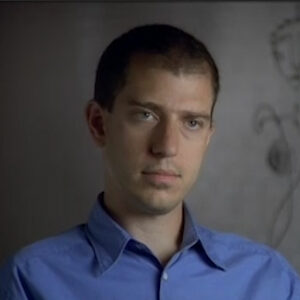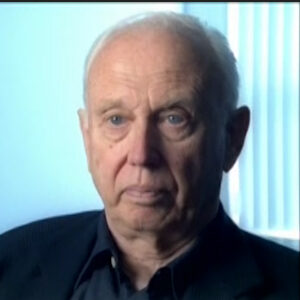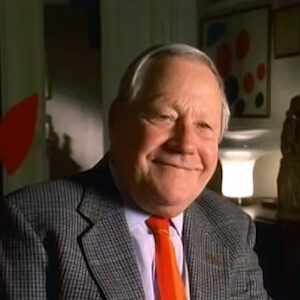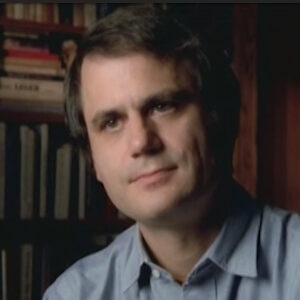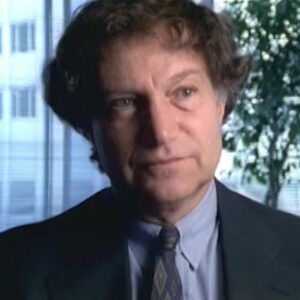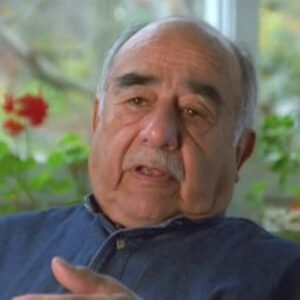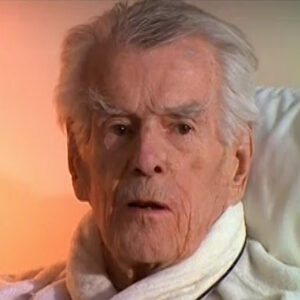Interviewer: OK, let’s jump right in. Who is Alexander Calder and why should we care?
David Ross: Alexander Calder was really one of the most remarkably American artists of the 20th century. And by American I don’t just mean that he came from a long line of Yankee tinkers and that he was born in the Northeast and lived the kind of American life and even had the luxury and and and and exotic pleasures of life as an American expat in Paris. I mean, American in the sense that his work was about invention. About joy, about. About the kind of playfulness that’s at the heart of the creative process. Calder maybe more than any other artist of the century, surely more than any other American artist, talked about how the creative urge to make something beautiful, to make something new to to plumb the essence of what life was about could be accomplished with means that brought a smile to people’s face. That enlivened as a situation or a place. The idea that sculpture could move, that it could be freed from its pedestal, but it could be freed from the idea of stillness was a very radical idea. And it took a tinker’s son or grandson to make that kind of move. It took an American inventive genius, combined with the kind of sophisticated understanding of color and form the language of surrealism, the not the notions of symbolism that were suffused within the art world of his more of his time. The idea of turning everything on its head. It took that kind of an artist to come to that kind of an idea. It took an artist like Alexander Calder who could invent a circus to play with for children who he would encounter in the homes of his friends. To take ordinary materials and transform them into high art rather than remaining reliant upon the vocabulary of the Academy of Bronze and Marble. Today would be steel.
Interviewer: He’s completely American but he went to France.
David Ross: Well, first of all, it’s completely American to go to France, or especially it was then, because American art was understood by its relationship to Europe. Very much so in the beginning of the century. Not so much today. Clearly, now that New York is seen as the center of the art world, the absolute necessity of a journey to Paris is not number one on any serious artist list of what they have to do. But at that point, going to Paris was critically important. Not that it’s unimportant today, but it’s less important. And Paris was a remarkable thing for Calder. Because it gave him a kind of reason for something that he inherently understood. It was really internal to him. But when he saw it there, reflected in the work of his contemporaries, when he saw and understood what was going on and the currents of European modernism and how his own understanding of American modernism collided and then in a way, kind of absorbed and transformed it. The Paris experience became critically important, as it was for Harper a half a generation earlier, that the the idea of confronting one’s European heritage, if you’re of European ancestry, was and in some way remains important for American artists, just like American artists from other parts of the world. In a way, I have to come to grips with who they are. And at that point in time. Understanding yourself meant coming to grips with yourself in relationship to Paris in the same way as it was for Picasso, a Spaniard. He had to come to grips with himself in relation to Paris, not just by the LOANA. And so we see that, you know, the collision of his ideas as he confronts the work of Brancusi, as he confronts the ideas of Picasso, as he understands the impetus and the complex psychological and intellectual motivations of surrealism that weren’t just about simple fun, but were about a deep understanding of the complexity of the human psyche as he understood and collided with the political and ideological rigour of Dadaism, which was not just about fun and games as it way was translated across the Atlantic in New York, but really came out of a serious, depressed understanding of the of the the life of Europe, post-World War One, as he confronted those things, his own ideas about his work himself, his art, the place of art in the world, the critically important role of an artist as someone who could restore joy in life and light and color to a world that was being drained of its life, that was being attacked on all sides, that was being turned into a less human place by the machines of modernity. He wanted to make machines that would do something else, not machines of war and death and destruction, but machines of joy, machines that brought a smile to people’s face that still do today. Even in our sophisticated post cybernetic age, a kid sees a Calder mobile. They smile. You know, there’s a reason why now every kid and every kindergarten art school makes mobiles out of paper cups and paper clips because that involvement, that idea of art being able to express human emotion and and movement and the stuff of life somehow took without having to be enforced academically or die tactically. He hit on something that was in our soul and he gave it life and form. And all you have to do is walk into the great hall of the National Gallery, walk into the Whitney when we have our new call, the galleries open in this next in the spring in 1998 and see the Calder moviles to see the stabiles, to see the circus, to see what he did with graphics, to see or even did with Tapestry, to understand that this was a man who was able to bring motion into art on every level, who was able to understand color in its direct, unfettered way and in a way better than any other American of his generation. You look at Stuart Davis and you look at Calder and you see that there was this kind of straightforward American understanding of color, not fuzzy stuff, but just direct, pure, vibrant, affecting.
Interviewer: What do you think drove him to create? He didnt seem to have a dark side like so many artists.
David Ross: Well, you know, the drive to create art comes from a lot of places in different artists. And when you look at Calder, whose art seemed to be synonymous with play, I mean, it looked easy. Of course it wasn’t. No, art is easy, but it was about a certain kind of playfulness. It was about living. You know, Picasso got up every day, made art, made love. It was all part of the same human experience of living a day. You couldn’t imagine living a day without both without making art and making love. And Calder had a similar attitude about art as a critical part of his life. It wasn’t his job that he did five days a week and then went to the weekend house out in the country. Art was what he did. It was an integrated thing. And in fact, his art speaks to a kind of integration of art in life. It’s one of the reasons why Calder’s works are so wonderful as public art, because they are such a natural connector, a buffer between what people tend to do with their lives to separate the pleasure from the workaday world. The quotidian from the special. Calder’s work was about connecting all of that. And of course, in order to make art that convincingly able to connect that, it has to be connected internally and with Calder it was. Making art wasnt work in that sense. It was the essence of who he was as a human being. And so he had to do it as simply as he had to breathe, as he had to eat. And he did it with the same kind of joy and passion and commitment and also great skill. Because, again, although we can make a little paper cup mobiles, the reality of the engineering and the complexity of those enormously complicated works is something we shouldn’t underestimate. They were they were beautiful, seemingly easy. But in fact, quite complicated.
Interviewer: You have probably seen as many Calder works as anybody. Hundreds perhaps thousands. What is that Calder do for you. What happens to you?
David Ross: Well, first of all, you know, whenever I see a Calder, I think I have this this knee jerk response that many people do. I smile. They always make me smile. I always think that there was this man with his spirit. And that spirit comes right through at you, through the work, you know, is a spirit of life and the spirit of joyfulness, the kind of childlike way in which his work brings you back to what art should be about, which is a reconnection with what’s most essential, a human inside of us. And we connect me with that in such a beautiful way. You know, many people have a problem with abstraction. And in fact, Calder is an abstract artist. He’s not a representational artist. But all those people who pooh pooh the idea of abstraction and want to make fun of it or or are simply are confounded by it. They don’t have that problem with Calder. Sometimes you have to call the attention to the fact that you know what you love here. This is abstraction, you know. That’s abstract. Oh, really? That’s abstraction. Gee, well, I like that. Well, of course they like it because he is understanding of abstraction was the idea of bringing organic forms that are very natural to our eye and bringing them into such harmony that they don’t conflict like like, you know, a peer of his, like Arp, for instance, or Brancusi. This is kind of understanding of the natural forms that are in the universe, something in a way, ironically very Asian that comes out of an understanding of finding the net, the forms in nature and refining them as a human product and calling that art. That was a radical move in the west. In the east it was kind of commonplace. And to bring that kind of understanding of natural forms by a morphism into the ideas of surrealism, into the kind of playfulness of of a Calder vocabulary always affects me in a very kind of very straightforward way.
Interviewer: It obviously took Calder a while to find himself, his style when he went to France. He started working in wire. Even before that he did some sculpting., figurtive things. Can you talk about him finding himself?
David Ross: The reality is that, you know, Calder took a journey that’s not so unusual for other great artists to take, which is a continuing journey of finding oneself. You know, everyone thinks that once he had made the great inventions, the great leaps in his career, that he had found himself. But increasingly. My colleagues and I and many others began to recognize that even in the 70s, in the period where one I. So I called her as the great established hero of American sculpture, making monumental sculptures for public spaces and great collections and a scale that he probably never imagined in the 20s and 30s. I believe he was still finding himself. The essence of an artist of value is that they never believed that they found themselves or have finished developing their vocabulary. They’re always refining it, even if those refinements are no longer visible to the to the eye of those of us who see one or two or even 10 works. But to the eye of the artist who’s on the inside of that invention, that ongoing process is what drives the artist. What’s compels them to try something again, slightly differently, with a slightly different balance, with a slightly different set of color combinations, with a slightly different physical presence. So I’m not sure that in this sense that you might say about some artists who are, in fact, less of less importants. Word is hard to use, in effect, but less important than Calder that I’m not sure that call it ever really found himself. I think that restlessness was part of the energy that you see in Calder’s work. And, of course, the vocabulary did become established early on the basis of the vocabulary. But we wouldn’t say that having found that basis, that it’s evolution or its refinement was of less value to the final sum total of what we now see as the body of work of an enormously protean American artist. I value the late, small developments as much as I value the great initial inventions.
Interviewer: Let’s go back to those initial iventions. Can you talk about wire portraits for a moment.
David Ross: Well, the wire portraits, an amazing invention, an amazing idea to take into three dimension to take into that material in a way, what could have been seen as a simple parlor trick by a man with very talented fingers. But in fact, these were much more than caricatures. These were not just, you know, cartoons. This was not just a simple play. There was a kind of complex portraiture which brought the quality of somebody into the round, into a three dimensional format for the first time. You know, there’s a great story about Calder coming to Cambridge, having a show with one leg. And Christine and Daniel Saltonstall, Jim Plowed and others were forming what later became the Institute of Contemporary Art in Boston. Then the Harvard Society for Contemporary Art. And they were very excited that they were going to do a show with Calder. This was in the early 30s and that he was going to be there. He was already a hero to them, to a young generation of young curators, young art historians. He was a kind of an artist at making his moment. And he they picked him up at the train. And he doesn’t have any any art with him. They’re flabbergasted. They’d scrape together money to bring him up to Cambridge, to have this show. And they said, Sandy, what’s going on? Where’s where’s the art? And he reaches into the pocket of his overcoat, pulls out a roll of a spool of wire. It says, here it is. And he goes off to the gallery with them and he creates the show on the spot. I mean, that is an amazing thing, not only because of what we can see is the surprise and the and the delivery of an amazing show by an artist who is really beginning to be at his prime. But also because of what is said about the idea of site specificity, you know, Calder invented that. I mean, we’re so now suffused with installation art, with site specific art, with art that seems to be on the cutting edge because the artist goes to a place understands more than just he has a show but tries to understand the nature of the physical place and the social aspect of the place and the sociological and even ideological nature of the space and then create work in reference to all of those elements to understand that modern art really is a complex response to not just simple visual facts, but a more complex and deeper understanding of modern life. And Caderl there was really one of the great pioneers of that because of his insistence on. Well, again. He may look at it as playfulness, but in fact, there’s a serious undercurrent to it all, a real deep understanding of where he was and where it was not just a matter of locating himself physically. It was a matter of understanding every aspect of where he was and who he was and who he was talking to. And that work, which started out as simple wire sculpture, then took more, more, more complex forms over time, remained anchored to a deep understanding of place. In a way, it’s why he’s perhaps one of the greatest public artists of the 20th century as well, because that understanding of place really carried over to being the the one who set the tone for what we now see as a national a national movement towards a embrace of public art and so many large and small and even teeny little towns and villages around the around the country.
Interviewer: He was doing wire sculpture as he started to move towards abstraction. Maybe you want to speak about the Josephine Bakers. Can you talk about the move towards abstraction?
David Ross: Well, again, they move towards abstraction for Calder, like many of his generation who are encountering those radical ideas for the first time, happened organically. It wasn’t something that he read about and decided to try. It was a way of distilling the essence of a moment. If you look at Josephine Baker, she was more than just extraordinarily talented and extraordinarily beautiful woman. But she was somebody whose energy transformed a room. Whose ability to to move transformed people’s souls. And he wanted to try to represent her. Well, how do you do that? You had to make. You had to make sculpture that somehow was going to be able to transform itself. It’s the ability to represent line. And all of a sudden transform into something that could start to move. That could start to insinuate itself to insinuate ideas of motion and sensuality to abstract from reality. Some essential quality of the human energy. That was Josephine Baker. And so is that notion of abstraction in its dictionary definition rather than in its art jargon definition. Now we start to see it was an ability to try to bring in to a an abstracted form the essential qualities of something that was in fact impossible to capture in stone that could only be captured in something more fluid.
Interviewer: So let’s let’s move on to mobiles. Mobiles- Is it clear that they come out of wire sculptures?
David Ross: Well, you know, what’s clear to art historians may, in fact, have no relationship to reality whatsoever. So we always have to have that caveat. It seems that there is a progression. It seems to us, looking at the whole history, one piece following another, that is progression. Calder like to talk about that and indicated that, in fact, that that made some sense to him. And yet he did all those things. In an overlapping way, it wasn’t like a machine where one thing literally followed another and was never done again. He continued to do all the things he did throughout his life. And so there was a an iterative quality of one form of art making, whether it was those exquisite pencil drawings, which, you know, you can’t ignore. I mean, you can’t look at those wondrous lines and that that he was able to put on paper and not understand that those are the same wondrous lines that he was able to transform to wire and that those lines describe the same wondrous arcs and eclipses and ellipses that the forms themselves would make as they moved in space. And that sense of line, which originally came from the hand and just that simple pencil and paper, that’s really the quality there. The sense of flow, the sense of form, no matter what physical form it took, was really at the core of the work, a sense of balance and proportion and again, a sense of its relationship to organic realities, to the things that we see in the world that come to us in our dreams, that remain in our mind’s eye, are able to be recaptured by an artist of the quality and talent in and inventive vision of Alexander Calder.
Interviewer: Can you talk about whether he actually invented an artform?
Speaker You know, it starts to become sort of like Madison Avenue to think about inventing an art form, you know, does anyone invent anything in art? I’m not so sure. I mean, if we want to be in the world of salesmanship, we can say, you know, new, improved, invented art form. I think all artists take from everything around them. And the great ones, manages to synthesize something that transcends all of the pieces that they’ve brought together in their lives, their own personal histories, their families, their surroundings, the artist that they know, the women that they love and where they can synthesize all of that into something that transcends it all. And next, say it doesn’t matter where it came from. Look at that. That’s all we know, we have something special, and that’s what’s important about Calder. Yes, the mobile term. He didn’t use, but it was applied to his work is something he seems to be the first to have done. Is that, in fact, important only in the Guinness Book of Records sense of the word. What is important is the effect, the impact of that kind of art has had on subsequent generations of artists who felt and were also liberated in ways that the modern sculptor has been liberated from the traditions and canons of.
Interviewer: Tell me why the circus was such an incredible thing?
David Ross: Well, the circus developed a life of its own. I mean, here, this enormously gifted sculptor making complex and sometimes very large and tough works for their moment, did something ostensibly for children, although that wasn’t. I mean, children love that but so do adults. Because he ceated an entire circus that he animated himself with all of the characters and characteristics of a circus. And he brought life into this sculpture by personally performing this. Now, what did that mean? Of course, if Sandy Calder called, I was at your house. I mean, I’ve heard some people say that it got to a point, whereas Sandy would show up with suitcases and theu go Oh, my God. Here goes again. I’m sure that happened. You know, I’m sure of her. But I’ll bet ninety nine times out of 100 people thought, oh, my God, we’re going to see this work happen. And if there were kids in a house, they’re probably in the front of it. And it was this artist insisting that life itself be part of the sculptural activity. What did that mean? That the living sculptor animated the sculpture within this narrative of the circus which, of course, is a metaphor for life that we all understand. And indeed, this was such an incredible verve and style and energy that it transformed audiences all over the world. It meant in a way, that what Calder was participating in what we see today as performance art and and has developed in a way is almost a sub a sub genre within the world of of painting and sculpture. That point was a simple insistence on the part of the artist that art and life had to be more combined. That one of the problems that the world was confronting was this continuous extraction of art from life and the separation of that which we hold dear to us and and worship as the transcendent human experience and the quotidian. On the other hand, needed to be brought back together. That was the essence of Calder’s sensibility, was bringing art and life together. And what better way to both do it physically and do it symbolically than to enact this wonderfully funny and witty and beautifully constructed and delicate circus like some kind of mad man? With all the sound effects and whistles and craziness that a circus would have done by one man and my understanding of the circus, which I’ve never saw, performed by by the artist, but I’ve seen so many thousands of times on that wonderful French film that we show here at the museum where we display this circus. Was that call there successfully managed to transcend the idea that sculpture is something that’s done, that’s finished, that’s looked at and managed to insist and in fact insinuate into the consciousness of thousands, if not tens of thousands, if not millions of people, that sculpture that art has to remain alive, to remain functioning. And his ability to do that and the fact that these objects that I still retain some of that quality. But quite frankly, you need to see the film. You need to understand how they were used to really understand that this is not just a quirky little bit of miniature sculptures by a great artist. If this was a prop that was part of the insistence of an artist on life as the essential quality of his art.
Interviewer: Something you said triggered a question I wanted to ask before about the moving sculpture and that is what about this idea he had that the artist shouldn’t determine the final form of the scultpure. Can you talk about that?
David Ross: Well, it was it was it was both a Democratic gesture with a small D. As well as and understandably…
Interviewer: Explain what is was.
David Ross: Calder felt very strongly that that works of art had to change over time, that the artist couldn’t just say for all times that a form would take this shape and that would be it. That forms would change. They would evolve. People live and die. Things happen. The organic forms of his art were mirrored by an understanding of the organic nature of change itself. And you couldn’t just have an organic form as the essential organic quality of an art without also understanding that change itself. That the randomness and indeterminacy which are today a part of a post John Cage and universe are day to day Universe really was brought into art by by Calder’s very profound understanding that the artist couldn’t be so arrogant as to say that a work of art remained fixed, that wind and chants or even. And I’m not saying that anyone should come into the Whitney and do this, but even someone touching a Calder sculpture and playing with it would change it would transform it would give it a new essential quality look and would in fact be part of it. What is really essential about its its existence, which is its ability to continually change.
Interviewer: Talk about stabiles. You probably know, that in the 30s when he started the small stabiles, he was hoping to get commissions for bigger ones. It didn’t happen until later. And much later for the very big ones in the late 50s. Can you give us a two sentence description of one other sculpture was going on and where he came out of for stabiles.
David Ross: I rather not talk about that. No, I don’t wanna go in that direction.
Interviewer: Well, tell me what your take on stabiles. Is it new? Are stabiles new also?
David Ross: I mean, of course, the notion of the stabile, what we call a stabile or a stablie. It is described, obviously, in relationship to an opposition to the notion of the mobile. So you have these these forms that in fact were about motion and inset. And in reality, he was also interested in in working with forms in a more traditional sense, out of the traditions of of of of of solid sculpture. And dealing with other kinds of imagery that you couldn’t address in a moving form that weren’t necessarily about the kinds of issues of balance and color and light that you could that you could extract in a tabletop or in a monumental form. He was interested, of course, in the issues of monumentality, in issues of scale, of how a sculptural form could participate in and a dialogue with architectural forms. When we see the great stabiles that were built in the 70s when Calder came into his own. And when the great commissions came his way, fortunately it came as way while he was alive. And he was able to see some of these ideas which began as as tabletop Marquette’s really evolve into works that could stand beside some of the great architectural monuments of our time. Then you understand that he was talking about how the organic form could take its place next to the modern and the modern architectural form and could soften and suffuse a modern urban landscape with a different kind of human sensibility. One only has to look to Chicago or to Grand Rapids, whereby the way one of the great stabiles really transformed a city. He was a city that was so hostile to the idea of a Calder when it happened, when it was first started to happen, that the people who brought it about, the Keeler family, wonderful, public spirited people in Grand Rapids, had to fight hammer and nail to bring this about and use all their political clout. Ten years later, that that great work of public sculpture transformed the consciousness of a city. I mean, they call their emblem is is printed on the sides of the garbage trucks of that city. It’s become the image of a city. And why? Because they recognize that the human quality of those organic forms was able to take the urban space and transform it into a more human place. And that’s what was in his mind. But he couldn’t tell people that. He had to show them that. And, you know, to get those kinds of commissions while he was this is, say, a generation ahead of his time. But one time, fortunately caught up with him and he was able to prove his point. I think the world began to see that, that bringing artists into public life, bringing those kinds of forms into play with with sometimes very brutal architectural forms in our cities had a humanizing impact and a capacity to transform the quality of life itself.
Interviewer: We have one minute talk about the utensils in this house and how that was part of his…
David Ross: Well, as we know, the issue of Calder, was no separation between art and life. What an artist does is what an artist does. And whether was jewelry, which was fantastic. And if you’ve never seen a woman wearing a fabulous call or necklace, you’ve not seen a perfectly dressed up woman or salad forks, you know, which transform a meal. He realized there was no reason to say this is art. This is not art. This is art. This is life. The artist should have his hand in all of it. And with Calder, there was no area that he wouldn’t play with and try to transform with his unique vision.
Interviewer: Let’s cut. I have one more question.
David Ross: The traditions and canons of of academic 19th century sculpture. That’s what’s really important. I mean, you couldn’t have a Carl Andre without an Alexander Calder. You couldn’t have Richard Sarah without Sandy Calder. And yet one wouldn’t say that there’s a direct relationship there either. Yet the freeing, the continuing freeing of the sculptor from the restraints of the academy, from the idea of of an object placed on a pedestal in a certain kind of format, defining sculptures, boundaries that breaking down, that insisting on the complete ability to freely invent sculptural forms. I think we give call there a lot of credit for that.
Interviewer: Is Calder overrated?
David Ross: You know, the question of whether Calder is overrated comes up all the time, and it’s odd because, in fact, it begs a bigger question. Do we then we dismiss art becomes popular because of its quality, because of its ability to reach out on many levels and talk to people in a variety of ways, both on a very sophisticated level of the evolution of art throughout the history, throughout the history of art and the slow evolution of one’s style to another. And the thing that draws serious critics and curators and collectors, perhaps when artists, but also the arts, simple ability to just grab your heart, to just compel you to look to bring the smile. Does that disqualify? Are those ideas in conflict? Well, sometimes yes. Sometimes no. In the case of Calder, I’d say no. I say the fact is that calls are very carefully and thoughtfully set out to do both things. He wanted his work to appeal to be part of the American scene, to be part of the world idea of what art could be. He was an American with that idea that art should transform everyone’s life. It was a democratic thing. It wasn’t just for the rich who could afford to buy it. And yet he was also a very serious artist. A student of art. Some who thought about what art could do, what he could do, what was being done by others. And so both of those things were an actual actually when pretty good harmony and real balance. And so in this case, I think. Yes. Popular. Yes. Great.
Interviewer: How do you think Calder should be remembered. What is his place is?
David Ross: Well, I think color is already remembered as an as an American artist who brought the idea of joyfulness and play into art.
Interviewer: OK. Take two.
David Ross: I think Calder will be remembered, obviously, for his mobile.
Interviewer: We do. Yes.
David Ross: I think Calder will be remembered for his great mobiles. Of course, that’s what the common understanding of him, of him is and his contribution. But I think on a more profound level, Calder will be remembered as an American artist who insisted that art had to be a joyful experience, had to be a way of going out of yourself and connecting to something larger. Yes, it’s strong. And it sprung from deep psychological motivation, like all art and especially the art of his period. But it came from they ever went somewhere else. It went to creating a an idea of Art’s connection to the world. It went towards an idea of understanding the forms of the world and how they relate to our live lives. I think Calder will be remembered as a great humanist, as an artist whose whose art gave us more than just another reason to smile. But kind of brought to brought two to a boil, the need for art to insist upon integration of that live life. That need for joy and that understanding of something that’s universal, universal and essential.
Interviewer: Thank you.
David Ross: You’re welcome.


